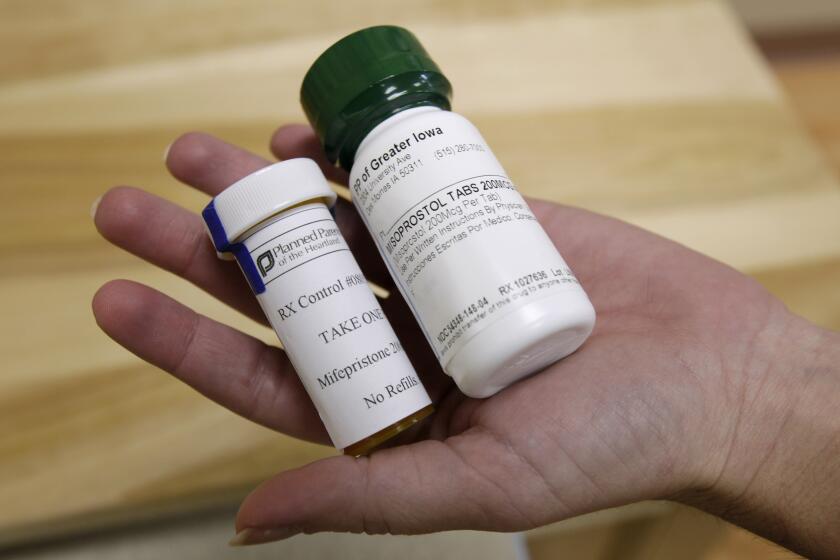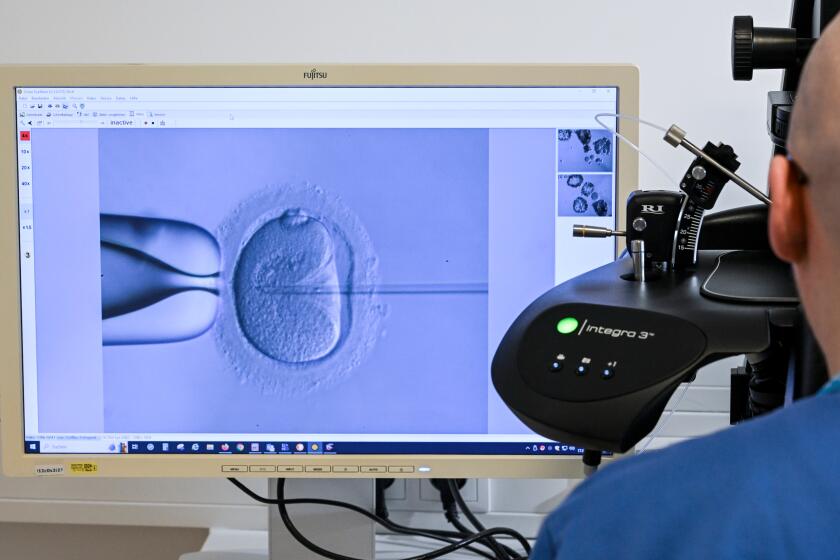Editorial: Don’t be fooled by Trump’s and Republicans’ abortion myths

- Share via
Abortion opponents peddle various myths about the procedure to discredit it and demonize the people who provide or support it. Abortion is healthcare. The earlier it is available, the easier it is for people to make choices about their bodies that will affect the rest of their lives. But during election season, expect to hear some or all of these fallacies as Republicans who oppose abortion inaccurately discuss it.
Abortion can happen after birth
None are as ludicrous as the myth Donald Trump pitched in the presidential debate in June when he said Democrats “will take the life of a child in the eighth month, the ninth month, and even after birth — after birth.”
Of course, there is no such thing as abortion after birth. Killing a fetus that emerges alive is infanticide. Abortion involves ending a pregnancy when the fetus is still in the uterus.
Supreme Court makes the right call on challenge to medication abortion’s safety, but the fight over reproductive rights in the U.S. is far from over.
In California, abortion is legal up to the point of the fetus’ viability to survive outside the uterus, which is around 24-25 weeks — or later if the abortion is necessary to protect the health or life of the pregnant person. The state is one of 20 where abortion is legal to the point of viability or a couple weeks less. In nine states and the District of Columbia, it is legal for any reason to have an abortion beyond that period.
“I think it’s exceedingly rare to do an abortion past 32 weeks even in states where there are no limits,” says Daniel Grossman, a professor of obstetrics and gynecology at University of California, San Francisco and the director of the the research program, Advancing New Standards in Reproductive Health.
In fact, only about 1% of abortions are performed past 21 weeks of gestation. When they do occur, they are usually done for severe fetal anomalies or to save a woman’s life, health or fertility.
The campaign by an antiabortion group to block the opening of a specialized clinic in Beverly Hills may offer a playbook for similar efforts in other cities and states.
Trump also falsely claimed that a former Democratic governor of Virginia said he was willing to “rip the baby out of the womb in the ninth month and kill the baby.” Not true. In fact, he said the opposite. In a 2019 interview, former Gov. Ralph Northam was asked about a Virginia state bill that would remove the requirement for three doctors to agree on whether an abortion was medically necessary in the third trimester. Northam, who is a pediatric neurologist, said that should be a decision left to the woman and her own doctor.
He then talked about a situation where a doctor induces labor to deliver a fetus with a severe health problem not expected to live. He said: “If a mother is in labor, I can tell you exactly what would happen — the infant would be delivered. The infant would be kept comfortable. The infant would be resuscitated if that’s what the mother and the family desired.” Keeping the baby comfortable without performing aggressive measures is sometimes referred to as perinatal hospice care.
Abortion is never necessary for emergency medical care
Yes, it is. If the amniotic sac ruptures prematurely, especially in the second trimester, that can lead to infection, sepsis, a possible hysterectomy or death. That’s why an abortion is often performed. (If the sac ruptures in the third trimester, labor can often be induced at some point.) A pregnant person who develops a condition where the placenta completely covers the cervix and begins to bleed heavily also may need an abortion.
An Alabama court decision brought national attention to the creeping personhood movement that seeks to extend legal protection to fetuses and embryos.
These kinds of severe complications were at the heart of the case the Supreme Court heard this session on whether the state of Idaho’s extreme abortion law prevented pregnant women from getting the emergency care required in U.S. hospitals that receive federal funding. In Idaho, some women with severe pregnancy complications had to be airlifted to other states to have emergency abortions. The court decided it should not have granted review of the case but did restore a lower court’s order blocking the part of the law requiring women to be near death before getting an emergency abortion.
Medication abortion is dangerous to women
Medication abortion — the most common abortion procedure in the U.S. — is a two-drug regimen that has been prescribed in the United States since 2000. Serious complications occur in less than one-third of 1% of uses. That’s safer than taking Tylenol.
The Supreme Court recently dismissed a case from a group of antiabortion doctors and organizations contending that mifepristone, the first drug in the regimen, had not been studied carefully enough by the U.S. Food and Drug Administration — despite the drug being safely in use for two decades. The court said the doctors had no standing to bring the suit since not one of them could identify a case where a doctor was forced, against their conscience, to perform a surgical abortion to deal with complications from a medication abortion.
A majority of Americans support reproductive freedom and have voted to protect abortion access since the Supreme Court abolished that right in 2022. That hasn’t stopped Republicans from trying to use fear and falsehoods to justify their campaign to further whittle down abortion rights across the nation. In an election season filled with rhetoric, a woman’s ability to control her own body should not be obstructed by lies about what that means.
More to Read
A cure for the common opinion
Get thought-provoking perspectives with our weekly newsletter.
You may occasionally receive promotional content from the Los Angeles Times.













